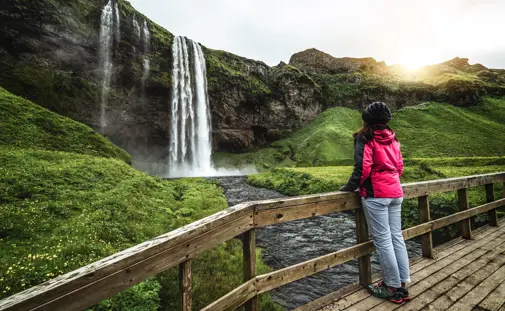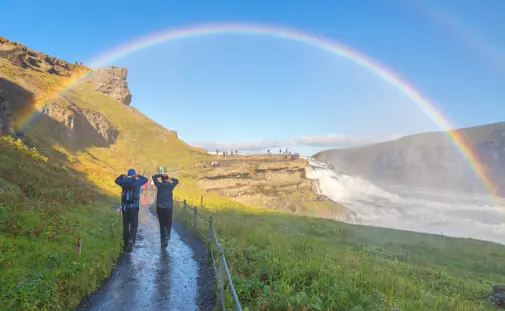Grjótagjá Cave is a small lava cave near Lake Mývatn in northern Iceland, renowned for its stunning geothermal hot spring nestled inside. The cave is known for its beautiful blue geothermal waters and its unique mix of tranquility and rugged, volcanic features, that today can be enjoyed from the outside looking in. The water temperature can vary, making it too hot for bathing, which is why the cave has been closed for such activities. However, the cave itself remains a spectacular sight with its jagged rock formations, dramatic lighting, and steam rising from the water’s surface.
Grjótagjá gained global attention after it was featured in Game of Thrones, but its history and appeal extend well beyond the screen. Grjótagjá offers visitors a fascinating glimpse into Iceland’s geothermal activity and volcanic landscapes, making it a must-see for travelers in the Mývatn area.
Grjótagjá Cave Facts
The Grjótagjá Cave is closed for bathing and entering, due to fluctuating temperatures. Visitors are prohibited to enter the cave but can view the internal hot spring from the outside looking in and take pictures. These information can change so always make sure to respect any signs and warning outside the cave.
-
Location: Near Lake Mývatn in northern Iceland, close to the town of Reykjahlíð.
-
Type: Lava cave with a natural hot spring inside.
-
Water Temperature: Generally ranges between 43-46°C (109-115°F) but can fluctuate depending on geothermal activity.
-
Accessibility: Bathing and entering the cave is prohibited
-
Fame: Featured in Game of Thrones (Jon Snow and Ygritte’s cave scene).
-
Cave Dimensions: The cave is approximately 10 meters wide and 5 meters high
Map of Grjótagjá Surrounding and Routes
Have a look at where Grjótagjá cave is in north Iceland on the map and find nearby attractions and the routes to get to the area.
History of Grjótagjá Cave
The Grjótagjá Cave is a natural landmark and testament to the rather lively volcanic history of Iceland. The cave formed during the lava flow of the 18th century, creating a hidden cavern beneath an uneven lava field. Geographically, this place lies on the Mid-Atlantic Ridge — an area marked by geological activities in the form of frequent volcanic eruptions that continue shaping the landscape.
Historically, locals enjoyed bathing in Grjótagjá. However, with the volcanic eruptions of the 1970s and 1980s, the geothermal activity drove the water temperatures inside the cave to as high as about 60°C or 140 °F — making it unsafe for bathing. In due time, these temperatures came down to more comfortable limits and are now usually ranging between 43-46°C or 109-115 °F, but do undergo changes according to geothermal activity.
Today, Grjótagjá cave is closed for bathing and entering. The cave sits on private land and was closed off to protect visitors from unsafe and fluctuating temperatures of the water. As well as poor treatment by guests. The landowners at Vogar constructed a gate by the main entrance and put up signs prohibiting bathing. Although the gate may not always be locked, guests are asked not to bathe or enter the cave.
Surroundings of Grjótagjá
Situated in the area with very special geological formations, Grjótagjá forms an excellent starting point for exploration of northern Iceland's natural wonders. Only a short distance away, Lake Mývatn conjures up a magical world for the visitor, offering an incredibly dramatic view and a fascinating glimpse into the contrasting landscapes that encircle it. This is a region known for its volcanic craters and rich birdlife, with beautiful trails where visitors can leisurely stroll and enjoy endless views of the contrasting blue lake and rugged lava fields. And if you are looking for a hot spring bathing experience, don’t forget that Mývatn Nature Baths are just a few minutes away from the cave.
The huge Hverfjall crater is a dramatic witness to Iceland's mighty volcanic past. Formed around 2,500 years ago, the huge, imposing shape of Hverfjall can be seen from miles off and is hiked by visitors for panoramic views across the entire Mývatn area. For anyone who is interested in the lava landscapes of Iceland, a closer attraction is the unforgettable Dimmuborgir Lava Fields to walk through. Aptly referred to as the "Dark Fortress," this weird almost sculptural creation was the work of ancient lava flows, creating trails among its maze of towering rocks and natural sculptures that is both eerie and beautiful.
Each of these sites provides a different view into the power and beauty of Icelandic nature, making any visit to Grjótagjá a part of a richly rewarding journey through some of Iceland's most intriguing landscapes.
Where is Grjótagjá Cave?
Grjótagjá is located near Lake Mývatn in northern Iceland. Specifically, it sits just a few kilometers east of the town of Reykjahlíð and close to Route 1, Iceland’s main Ring Road, making it easily accessible for travelers exploring the Mývatn region.
Grjótagjá is nestled between the active Krafla volcanic system and the Mývatn lake.
-
Grjótagjá Location: 65°37'34.8"N 16°52'58.8"W
How to get there
Grjótagjá Cave is located along the 860 gravel road just a short distance from the Ring Road, Route 1. Here are a few routes to help you get there from various starting points.
From Reykjahlíð the drive is approximately 3 kilometers (1.8 miles) and takes about 5 minutes. Drive southeast from Reykjahlíð, taking route 1 toward Mývatn then turn south onto gravel road 860 where you’ll see a sign pointing to the cave.
From Reykjavík, Grjótagjá Cave is about 470 kilometers (292 miles) away, making it a longer but rewarding journey through Iceland. Start by driving north on Route 1 from Reykjavík, passing through charming towns like Borgarnes and Akureyri. Once in Akureyri the journey to Grjótagjá is approximately 80 kilometers (50 miles), or about a 1 hour drive. Once at the Mývatn area, head east past Reykjahlíð, and turn south onto gravel road 860 where you’ll see a sign pointing to the cave. The entire drive from Reykjavík takes approximately 5–6 hours, allowing plenty of time to take in Iceland’s remarkable landscapes along the way.
Parking and Facilities
Parking is right next to the cave (2 min walk) and much to your luck it’s still free. Despite its fame Grjótagjá Cave has not been commercialized and does not include any on-site facilities apart from the non-paved car park.



